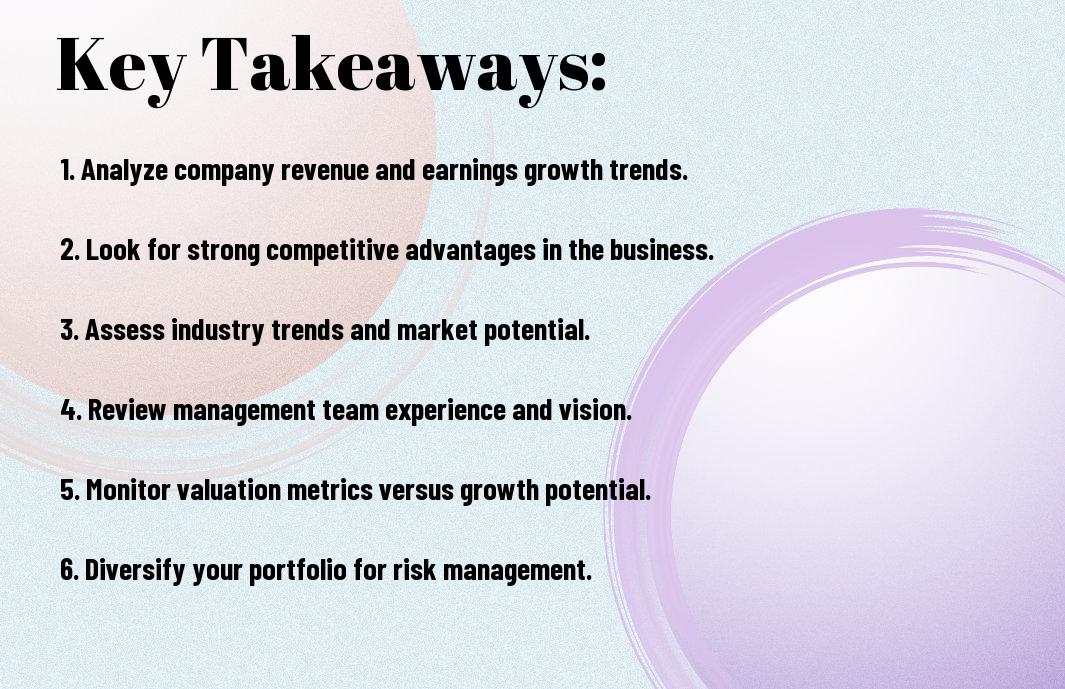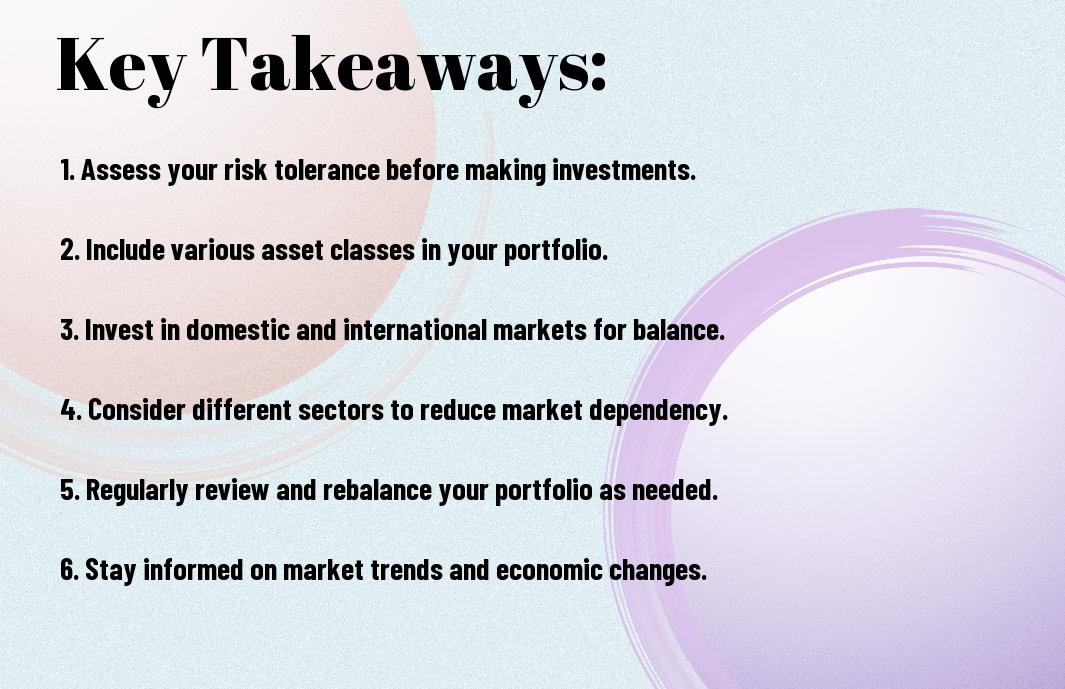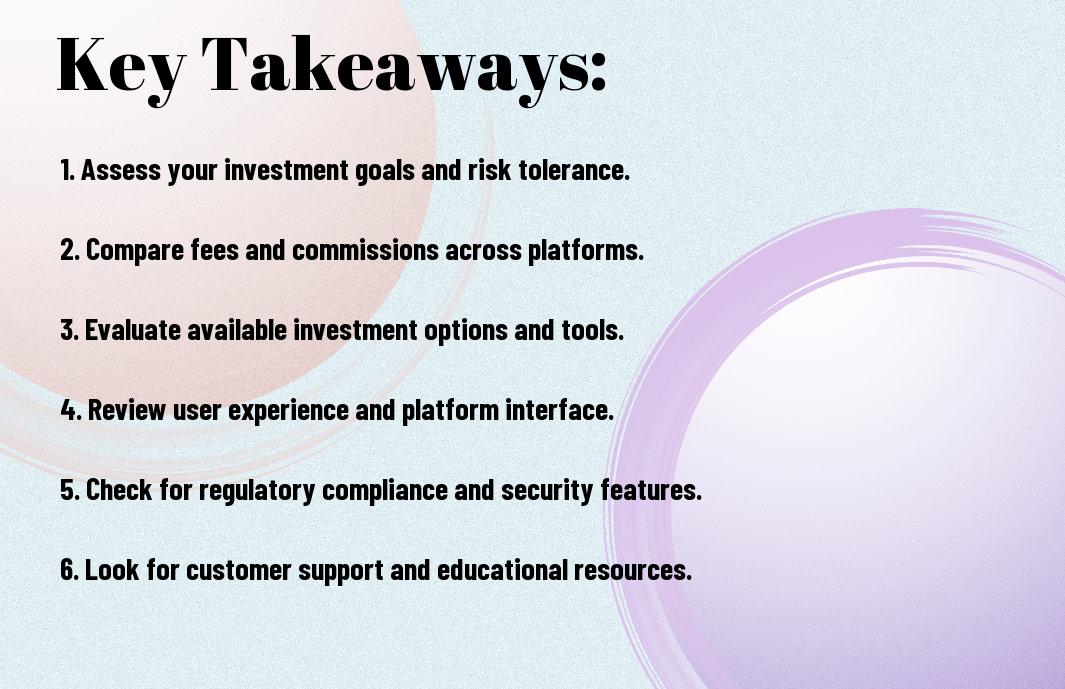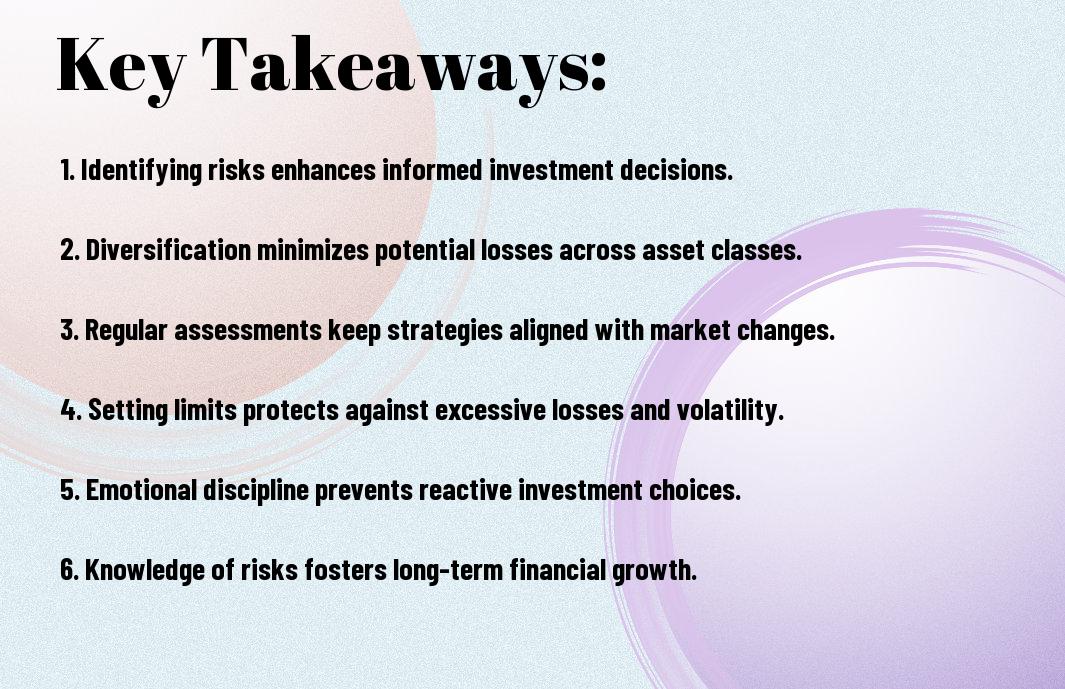You can protect yourself from investment scams by learning how to identify common red flags. Scammers often use high-pressure tactics, unsolicited offers, and promises of guaranteed returns to lure you in. By understanding these warning signs and conducting thorough research before making any investment decisions, you will empower yourself to navigate the financial landscape safely. This guide will equip you with practical tips to help you discern legitimate opportunities from deceptive schemes, ensuring that your investments are both wise and secure.
Key Takeaways:
- Red Flags: Look for warning signs such as promises of high returns with little risk or pressure to invest quickly without adequate information.
- Research: Always conduct thorough research on the investment opportunity, including reviews of the company and the individuals offering the investment.
- Verification: Check if the investment firm is registered with relevant regulatory bodies and confirm its credentials and history.
- Unsolicited Offers: Be cautious of unsolicited investment offers, especially those received via email or social media, as they often lead to scams.
- Consult Professionals: Seek advice from financial advisors or professionals before making significant investment decisions to ensure the legitimacy of the opportunity.
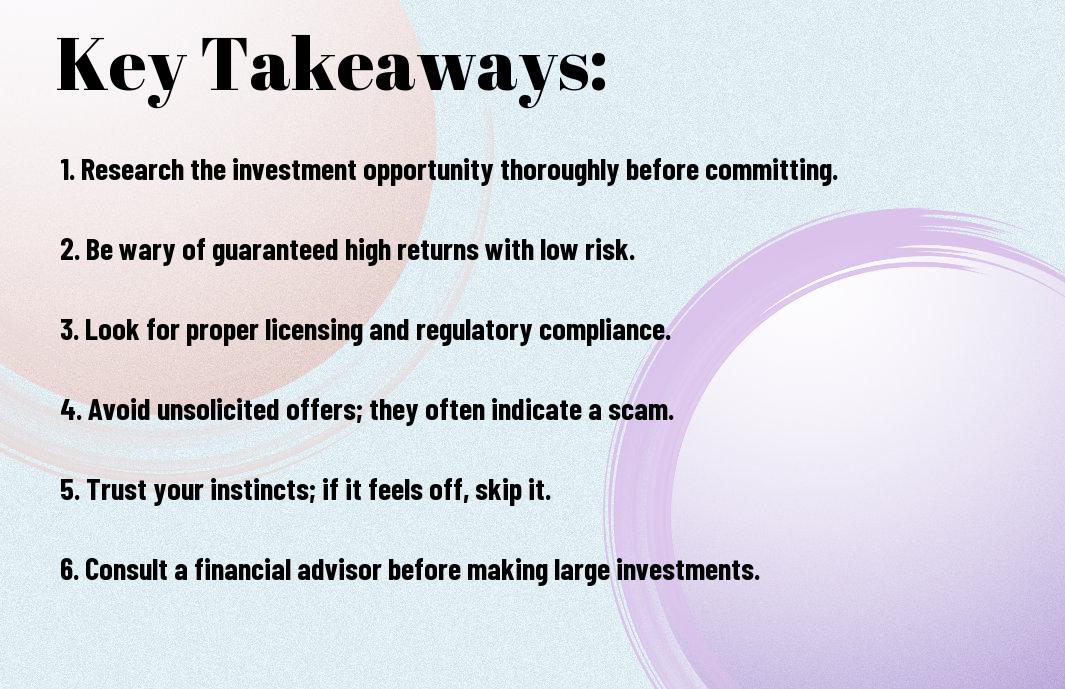
Understanding Investment Scams
A clear understanding of investment scams is imperative for protecting your finances. These scams often promise extraordinary returns with little to no risk, luring victims into false opportunities. To better safeguard against these fraudulent schemes, you can explore the Steps You Can Take To Avoid Investment Fraud.
Common Types of Investment Scams
An array of investment scams can trap unsuspecting investors. The most frequent types include:
- Ponzi schemes
- Pyramid schemes
- Advance-fee fraud
- High-yield investment programs (HYIPs)
- Pump-and-dump schemes
Knowing these scams can help you identify and steer clear of risky situations.
Red Flags to Watch Out For
Around every investment opportunity, certain red flags can indicate potential fraud. These might include aggressive sales tactics, promises of guaranteed returns, or lack of clear information. Always proceed with caution when you notice any warning signs.
At the very core of recognizing scams, ensure you’re skeptical of investments that appear too good to be true. High-pressure tactics and unsolicited offers often signal deception. Genuine investments come with risks and require due diligence and transparency. Protecting your interests starts with being alert to these red flags and conducting thorough research before committing your resources.
How Scammers Operate
Some scammers employ sophisticated strategies to lure you into their traps. By projecting an image of legitimacy and success, they manipulate emotions and create a false sense of security. You may encounter advertisements, unsolicited emails, or phone calls that promise lucrative returns, preying on your desire to grow your wealth quickly.
Tactics and Techniques Used
The manipulation tactics used by scammers often include high-pressure sales techniques, urgency in decision-making, and the promise of guaranteed returns. They may showcase fake testimonials, elaborate websites, and socially engineered narratives that entice you to invest without conducting due diligence.
The Role of Social Proof in Scams
The presence of social proof can be a powerful tool in convincing you to invest. Scammers often showcase supposed success stories from other investors, leveraging testimonials and endorsements to create the illusion of widespread approval and trust.
Considering the influence of social proof, you may be swayed by the testimonials or peer endorsements presented by scammers. They expertly craft narratives that highlight the experiences of others who have supposedly profited, making it appear as if the investment is both popular and safe. This can lead you to overlook red flags and make impulsive decisions based on the fear of missing out, rather than on sound investment principles.
Researching Investment Opportunities
Many investors underestimate the importance of thorough research when considering new investment opportunities. Taking the time to investigate the legitimacy, history, and potential of an investment is vital to safeguarding your finances. Utilize reliable sources, consult financial experts, and analyze market trends to ensure you’re making informed decisions that align with your financial goals.
Importance of Due Diligence
Alongside research, conducting due diligence is vital to protect your investments. This process involves verifying information, assessing risks, and understanding the intricacies of the opportunities you consider. By being diligent, you can spot red flags, avoid common pitfalls, and enhance your likelihood of achieving a successful investment outcome.
Resources for Validating Investments
One effective way to validate potential investments is by leveraging various resources such as financial news websites, regulatory agencies, and industry reports. These tools provide valuable insights and data that can guide your decision-making process and help you discern between legitimate investments and scams.
Considering the vast amount of information available, it’s vital to choose reputable resources that provide accurate and up-to-date information. Websites such as the Securities and Exchange Commission (SEC), Financial Industry Regulatory Authority (FINRA), and databases like Morningstar can be excellent places to start. By utilizing these resources, you can cross-verify claims, assess the track record of investment opportunities, and gather comprehensive insights that will support your investment choices.

Protecting Yourself from Scams
After learning about investment scams, it’s important to adopt protective measures. You can safeguard your finances by staying informed, conducting research, and recognizing red flags. Be vigilant about the sources of investment opportunities and always question anything that seems too good to be true. Implementing a proactive approach will help you build financial resilience and ensure your investments are secure.
Strategies to Minimize Risk
One effective way to minimize risk is by diversifying your investment portfolio. By spreading your investments across various asset classes, you reduce the impact of a poor-performing investment on your overall financial health. Additionally, ensure that you only invest money that you can afford to lose, which will give you added peace of mind.
Building a Support Network
From seeking trusted mentors to joining investment clubs, building a support network can significantly enhance your investment decisions. Surrounding yourself with knowledgeable individuals provides access to valuable insights and guidance, helping you detect potential scams more effectively.
This network can be instrumental in sharing experiences and warnings about questionable schemes, allowing you to learn from others’ mistakes. Engaging with reputable professionals such as financial advisors can also bolster your understanding and provide the confidence you need to make informed investment choices. By collaborating and communicating with others, you can create a robust defense against scams.
Reporting Suspected Scams
Despite the prevalence of investment scams, many people hesitate to report them, fearing it won’t make a difference. However, voicing your concerns can help authorities track down fraudulent activities and protect others from falling victim. By taking action, you contribute to a safer investment environment and assist in holding scammers accountable.
Authorities to Contact
Along with local law enforcement, you should reach out to federal agencies like the Securities and Exchange Commission (SEC) or the Financial Industry Regulatory Authority (FINRA) when you suspect a scam. These organizations have the expertise and resources to investigate fraudulent schemes effectively. Providing detailed information increases the chances of them taking action.
Importance of Raising Awareness
On a broader scale, raising awareness about investment scams empowers your community to recognize and avoid potential threats. Sharing your experiences or the signs of scams with friends and family can create a more informed public, leading to fewer victims and a stronger financial ecosystem.
Another effective measure for raising awareness is engaging in community forums or workshops focused on financial literacy. By participating in or hosting discussions, you can help disseminate crucial information about recognizing investment red flags and understanding legal rights. Collective knowledge reinforces the importance of vigilance and can significantly decrease the likelihood of scams impacting individuals in your community.
Legal Protections and Consumer Rights
For investors, understanding the legal protections and consumer rights available can serve as a powerful tool in avoiding scams. You have protections under various laws and regulations designed to keep you safe, and being informed about these can help you make smarter investment decisions. Additionally, knowing how to report suspicious activity can help protect not only your own assets but also those of other investors.
Understanding Your Rights as an Investor
To ensure you are well-informed as an investor, it’s important to recognize your rights. You have the right to access transparent information about your investments, and you are entitled to protections against fraudulent practices. Familiarizing yourself with these rights helps empower you to act decisively against scams and seek recourse if you fall victim to them.
Available Resources for Victims
An array of resources exists for those who have fallen prey to investment scams. You can turn to local consumer protection agencies, financial regulatory bodies, and legal aid organizations that specialize in investment fraud. These entities can guide you through the process of reporting the scam and pursuing any potential recovery of your losses.
In addition, many online tools and hotlines are available to assist victims of investment scams. You can contact organizations like the Federal Trade Commission (FTC) or the Securities and Exchange Commission (SEC) to report fraud and receive assistance. Additionally, networking with advocacy groups focused on investment fraud can provide a supportive community and valuable information on how to navigate the aftermath of being scammed. Taking advantage of these resources can help you reclaim your financial footing and prevent future scams.
To wrap up
Drawing together the key points on identifying investment scams, it’s imperative that you remain vigilant and informed. Always conduct thorough research, be wary of promises that seem too good to be true, and ensure that any investment opportunity is backed by solid documentation. Trust your instincts; if something feels off, it likely is. By staying educated and cautious, you can protect your finances and make informed decisions that will benefit your investment journey.
Q: What are common signs of an investment scam?
A: Common signs of an investment scam include promises of high returns with little or no risk, pressure to invest quickly, lack of transparency about the investment, and unsolicited offers. Be wary if the investment opportunity sounds too good to be true, if the individuals are evasive when answering your questions, or if you are urged to keep the information confidential. Always do your research and ensure that any investment is legitimate before proceeding.
Q: How can I verify the legitimacy of an investment opportunity?
A: To verify the legitimacy of an investment opportunity, check if the company or individual is registered with relevant financial regulatory bodies, such as the SEC or FINRA in the United States. You can also look for investor alerts or warnings on their websites. Conduct in-depth online research and read reviews or testimonials from independent sources. Consulting with a financial advisor can provide additional guidance and help you make informed decisions.
Q: What steps can I take if I suspect I’ve encountered an investment scam?
A: If you suspect you’ve encountered an investment scam, it’s important to take action promptly. First, cease any further communication with the individuals involved. Gather all relevant documents and details about the investment, including emails, contracts, and advertising materials. Report the scam to local authorities, such as your financial regulatory agency or consumer protection agency. Additionally, consider sharing your experience on platforms that expose scams, which could help protect others from falling victim.
